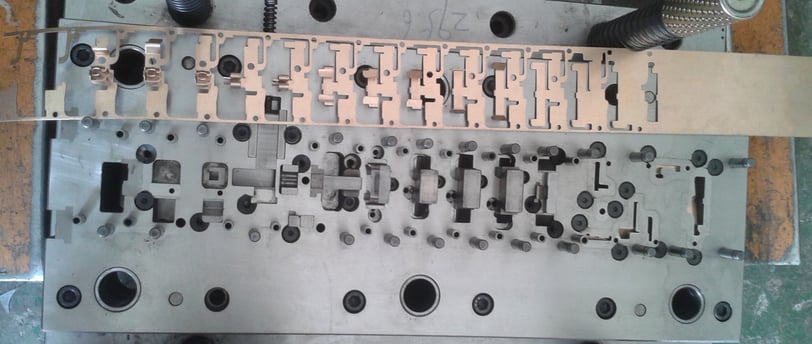Innovative Application of Stamping Molds in the Home Appliance Industry
2/27/2025


Introduction to Stamping Molds
Stamping molds are an essential component in the manufacturing sector, particularly in the production of home appliances. Defined as tools used to shape and form materials, stamping molds play a crucial role in producing metal parts through various stamping processes. These molds typically consist of high-strength materials such as steel or aluminum, chosen for their durability and ability to withstand considerable mechanical stress during production.
There are several types of stamping methods that utilize these molds, each suited to different application needs. Progressive stamping is one method where a single mold performs multiple operations in succession. This technique allows for the efficient production of parts in large quantities. Another method, transfer stamping, involves moving a sheet of material from station to station within the mold, allowing for greater flexibility in part design. Deep drawing is yet another method, which draws a flat sheet of metal into a three-dimensional shape through a series of forming steps. Each of these methods offers unique advantages in terms of material utilization and dimensional accuracy.
The advantages of using stamping molds in production include enhanced efficiency, cost-effectiveness, and precision. The automation of stamping processes significantly reduces cycle times compared to manual labor. Additionally, the precision with which stamps can produce parts minimizes material waste and increases the overall quality of the finished product. Furthermore, this technology has a rich historical background, having evolved over the past century to accommodate advancements in materials and manufacturing capabilities. Its importance cannot be understated, particularly in the home appliance industry, where the demand for reliable, high-quality components is paramount for consumer satisfaction.
Current Trends in the Home Appliance Industry
The home appliance industry is undergoing a transformative phase marked by the increasing demand for products that combine energy efficiency, compactness, and smart technology. As households strive to reduce their carbon footprint and enhance convenience, manufacturers are responding to consumer preferences through innovative designs and advanced functionalities. Current market data indicates a significant shift towards appliances that are not only energy-efficient but also integrate seamlessly with smart home ecosystems. This shift is particularly pronounced among millennials and tech-savvy consumers, who prioritize sustainability and convenience in their purchasing decisions.
Moreover, the trend towards smaller, more compact appliances has gained traction, driven by the rise of urban living and smaller living spaces. Consumers are looking for appliances that occupy less space while maintaining functionality, leading manufacturers to design products that maximize utility without compromising on performance. Compactness has become synonymous with modern aesthetics, blending form and function in a manner that appeals to contemporary consumers. This necessitates a shift in manufacturing processes to accommodate the production of smaller, high-quality components, which can be efficiently developed using advanced stamping molds.
Additionally, the integration of technology into home appliances continues to redefine the market landscape. Appliances equipped with smart features, such as IoT connectivity, offer users enhanced control and efficiency. For manufacturers, this means that there is a greater emphasis on creating high-quality, customized components that can be produced quickly and cost-effectively. Stamping molds play a crucial role in this context, allowing for precision engineering and the rapid production of parts that meet the evolving demands of the industry. Moving forward, the collaboration between technological advancement and innovative production methods will be essential in delivering products that not only meet but exceed consumer expectations.
Case Studies: Successful Implementations of Stamping Molds
The home appliance industry has witnessed significant advancements through the integration of stamping molds in manufacturing processes. A prominent case study is that of a leading kitchen appliance manufacturer, which adopted stamping molds for producing metal panels and brackets. Prior to this implementation, the company relied heavily on traditional manufacturing methods, which led to higher production costs and longer lead times. By transitioning to stamping techniques, the manufacturer was able to streamline its production line, resulting in a 30% reduction in manufacturing time. The precision of stamping molds allowed for tighter tolerances, enhancing the overall quality of the components produced.
Another notable example can be found in the production of enclosures for electronic appliances. A major player in the industry implemented stamping molds to create complex shapes that were previously challenging to manufacture using conventional techniques. This shift not only improved the aesthetic appeal of the products but also reduced material waste by nearly 25%. The use of stamping molds enabled the manufacturer to efficiently recycle scrap metal, further emphasizing sustainability in its operations.
However, integrating stamping molds into existing production lines is not without challenges. One key issue faced by companies was the initial capital investment required for new stamping machinery and mold design. To address this, firms often established partnerships with specialized mold design companies to share costs and expertise. Moreover, employee training was essential to ensure a smooth transition to the new processes. Companies implemented comprehensive training programs that equipped workers with the necessary skills to operate stamping machines confidently.
In observing these successful cases, it becomes clear that the application of stamping molds has led to marked improvements in manufacturing speed, product quality, and waste reduction. These advantages are driving more companies in the home appliance sector to explore stamping as a viable solution for production efficiency.
Future of Stamping Molds in Home Appliances
The future of stamping molds in the home appliance industry is poised for a transformative shift driven by technological advancements, including automation, Industry 4.0 integration, and artificial intelligence. As manufacturers increasingly adopt these innovations, stamping molds will evolve to meet the dynamic demands of the market. Automation will streamline production processes, significantly enhancing efficiency, reducing labor costs, and minimizing human error. This evolution enables faster turnaround times, allowing companies to respond promptly to consumer preferences.
Industry 4.0 technologies, characterized by interconnected devices and real-time data analytics, will further optimize stamping mold operations. Smart factories will leverage these technologies to create a more responsive and flexible manufacturing environment. For instance, real-time monitoring of stamping processes through IoT devices will facilitate proactive maintenance, reducing downtime and ensuring higher levels of productivity. Additionally, artificial intelligence will play a critical role in improving mold design and production techniques. By employing advanced algorithms, AI can predict potential issues in stamping processes, enabling manufacturers to pre-emptively address challenges.
Innovation in materials will also redefine the landscape of stamping molds. The development of lightweight yet durable materials will enable manufacturers to create more efficient home appliances while optimizing performance. Furthermore, advancements in design techniques and enhanced software solutions will facilitate the creation of increasingly complex mold geometries, allowing for greater precision and efficiency in production.
However, the future is not devoid of challenges. The home appliance industry will face intensified competition, necessitating continuous innovation to stay relevant. Additionally, as consumer demands evolve, manufacturers will need to adapt their stamping processes to align with changing preferences, particularly regarding sustainable practices. Addressing these emerging challenges while harnessing the potential of advancements will be crucial in shaping the future of stamping molds in the home appliance sector.
